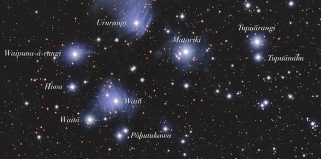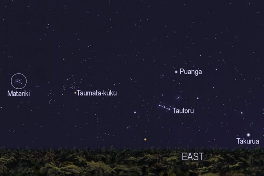Matariki
Nā Brittani Beavis
Article first published June 2021 in SmartBites magazine

What is Matariki?
Matariki, also known as Pleiades or the seven sisters, is a cluster of stars which show up around June signalling the Māori new year is approaching. As Matariki follows the lunar calendar not the Gregorian calendar - the dates change every year. This year, Matariki will be celebrated on July 14th, 2023. Matariki is important for Māori as it signifies the time to remember our tupuna, celebrate births, and look forward to the future.
What do the Seven Stars signify? (Matamua 2017)
- Matariki – Mother of the eight whetu (stars) in the constellation. Matariki symbolises wellbeing, our connection to the environment and the gathering of people. Shining brightly in the night sky would often be a signifier of good fortune and health.
- Pōhutukawa – This whetu is connected to those who have passed, particularly those passed since the last Matariki. “May you shine as stars in the night and sparkle within the repository of memories forever more.”
- Waitī – This whetu is connected to fresh water. Flowing water is sustenance for the land, vitality for mankind, and a food basket for the people. It also signifies when the korokoro leaves the ocean and migrates up freshwater streams to spawn.
- Waitā – This whetu is connected to the ocean and the kai gathered from it. Depending on where Matariki sits in the sky, it influences tides and floodwaters.
- Waipunārangi – This whetu is connected to the heavy rains of the winter months. We welcome the misty rain, the drizzle, the showers and the heavy drenching rain as they all fall from the sky to allow the land to grow and the people to flourish.
- Tupuānuku – This whetu is connected to kai grown in the ground, including all cultivated and uncultivated foods. When Matariki sets in the sky at dusk in May, it signifies the end of the harvesting season and the beginning of winter.
- Tupuārangi – This whetu is connected to everything that grows up in the trees, including fruits, berries and particularly birds. Historically, Matariki is the time of harvesting, cooking, and preserving birds who are rich in fat, as well as gathering berries.
- Ururangi – This whetu is connected to the winds, and determines the nature of the winds for the following year
- Hiwa-i-te-rangi – This whetu is the wish of the desiring heart; the determination of the longing heart. Spread out in plenty the multitude of immense opportunities, hold firm to good fortune! This whetu is connected to the promise of a prosperous season, and Māori will send up their desires and aspirations to Hiwa for the coming year.
How to celebrate Matariki?
You can celebrate Matariki any way you like. You may wish to spend time with whānau and friends, reflect on the year, and plan goals for the new year. You may take the opportunity to visit the Matariki Festivals around New Zealand, try different kai and immerse yourself into Māori culture. Or you may choose to wake up before dawn and look to the sky and see if you can find Matariki. You can do this by looking for the three stars at the bottom of Orion’s belt (or the pot), then look above the pot for a bright star, then look to your left until you see cluster of stars - this is Matariki.

Picture acknowledgements: Te Ara
Need more information?
There are many different places to find information about Matariki. I have listed some websites below and a beautiful pukapuka by Rangi Matamua.
Matariki Guidebook | Te Iwa o Matariki | TWoA
Matariki is more than just a holiday | The Spinoff
Matariki, our guiding light | The Spinoff
References:
Matamua, R. 2017. Matariki: The Star of the Year. Huia Publishers.
Meredith, P. 2021. 'Matariki – Te Tau Hou Māori - Cycles of life and death'. Te Ara - the Encyclopaedia of New Zealand, http://www.TeAra.govt.nz/en/diagram/5159/matariki-in-the-night-sky